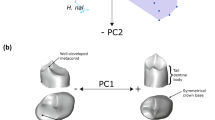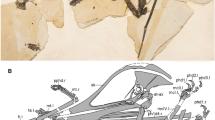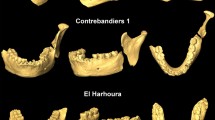Abstract
THE portion of a hominoid mandible (KNM*–FT 45) found in 1962 at Fort Ternan in Kenya has been referred provisionally by Leakey1 to Dryopithecus (sensu strictu). Simons2 has agreed essentially with this. Other primates found at Fort Ternan include the maxilla fragments of Ramapithecus wickeri (Leakey) 1962 (ref. 3), several individuals of Pliopithecus, and several isolated teeth attributed to Proconsul and Oreopithecus. By size alone the mandibular specimen (KNM–FT 45) can be distinguished from all these except R. wickeri. A detailed examination of occlusal relationships between the upper teeth in the maxilla of R. wickeri (KNM–FT 46)† and the two premolars in KNM–FT 45 suggests that the two specimens belong to the same individual; and even if this is not so they definitely belong to the same species. Simons4 and Pilbeam5 have argued that Leakey's taxon Kenyapithecus wickeri is a junior synonym of Ramapithecus punjabicus (Pilgrim) 1910 (ref. 6), but the evidence indicates at least a species difference, and this is the position I take here.
This is a preview of subscription content, access via your institution
Access options
Subscribe to this journal
Receive 51 print issues and online access
$199.00 per year
only $3.90 per issue
Buy this article
- Purchase on Springer Link
- Instant access to full article PDF
Prices may be subject to local taxes which are calculated during checkout
Similar content being viewed by others
References
Leakey, L. S. B., Nature, 218, 527 (1968).
Simons, E. L., Nature, 221, 449 (1969).
Leakey, L. S. B., Ann. Mag. Nat. Hist., 4, 689 (1962).
Simons, E. L., Proc. US Nat. Acad. Sci., 51, 528 (1964).
Simons, E. L., and Pilbeam, D. R., Folia Primat., 3, 81 (1965).
Pilgrim, G. E., Rec. Geol. Surv. India, 40, 63 (1910).
Pilbeam, D. R., Nature, 222, 1093 (1969).
Simons, E. L., S. Afric. J. Sci., 64, 110 (1968).
Pilbeam, D. R., Bull. Peabody Mus. Nat. Hist., 31, 1 (1969).
Mill, J. R. E., J. Linn. Soc. (Zool.), 47, 1 (1966).
Jolly, C. J., Man (NS), 5, 619 (1970).
Ryder, J. A., Proc. Acad. Nat. Sci. Philad., 45 (1878).
Campbell, B. G., Human Evolution (Heinemann, London, 1967).
Pilbeam, D. R., quoted in Tattersall, I. M., Man's Ancestors (Murray, London, 1970).
MacDougall, J. D. B., and Andrew, B. L., J. Anat., 87, 37 (1953).
Cave, A. J. E., and Haines, R. W., J. Anat., 74, 493 (1940).
Jolly, C. J., Man (NS), 5, 5 (1970).
Groves, C. P., and Napier, J. R., Proc. Eighth Internat. Congr. Anthrop. Ethnol. Sci., Tokyo, 3, 273 (1968).
Author information
Authors and Affiliations
Rights and permissions
About this article
Cite this article
ANDREWS, P. Ramapithecus wickeri Mandible from Fort Ternan, Kenya. Nature 231, 192–194 (1971). https://doi.org/10.1038/231192a0
Received:
Revised:
Issue Date:
DOI: https://doi.org/10.1038/231192a0
This article is cited by
-
The Origin of Homo sapiens in the Light of Different Research Methods
Human Evolution (2006)
-
A reassessment of the taxonomic and phylogenetic affinities of the fossil catarrhines from fort Ternan, Kenya
Primates (1992)
-
Zum Ursprung der Hominidae
Naturwissenschaften (1981)
-
Evolution of type C viral genes: evidence for an Asian origin of man
Nature (1976)
-
Reconstruction of the Dental Arcades of Ramapithecus wickeri
Nature (1973)
Comments
By submitting a comment you agree to abide by our Terms and Community Guidelines. If you find something abusive or that does not comply with our terms or guidelines please flag it as inappropriate.



